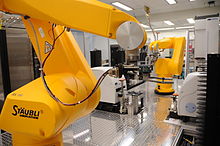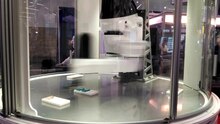Stäubli International
| Stäubli International AG
|
|
|---|---|
| legal form | Corporation |
| founding | 1892 |
| Seat | Pfäffikon SZ , Switzerland |
| management |
|
| Number of employees | 5,500 |
| sales | 1.3 billion CHF |
| Branch | mechanical engineering |
| Website | www.staubli.com |
| Status: 2018 | |

Stäubli International AG is an international Swiss technology group. The main activities are divided into the three areas of textile machines, quick coupling systems and industrial robots.
The company employs 5500 people worldwide. They work in 12 production plants (Germany, France, Switzerland, Italy, USA, China) and 25 national agencies (USA, Japan, India, Italy, Mexico, France, Brazil, Hong Kong, Germany, Turkey, Singapore, Thailand, Indonesia, Belgium , Poland, Czech Republic, Austria, Switzerland, Spain, Russia, Portugal, Taiwan, Korea).
history
Stäubli was founded in 1892 by Hermann Stäubli (1867–1940) and Rudolf Schelling under the name Schelling & Stäubli as a repair shop for textile machines in Horgen on Lake Zurich. In 1893, the first was Dobby (Rattieren) delivered as self-construction.
In 1896 32 employees moved into their own company building at today's location (Stäubli Areal West) in Horgen, which was expanded in 1899 and 1937. In the same year, the first dobby that worked correctly to the shot was produced with a wooden card control. The first dobby with paper card reading followed in 1900. After Rudolf Schelling's death in 1906, his brother Robert Stäubli joined the renamed Gebrüder Stäubli company as a partner. The first counter-pull machine for sample cards made of wood is created. The first two-cylinder paper card dobby and the first name weaving machine were made in 1937. In 1955, the first counter-pull machine followed, with no functional play.
In 1943 the four textile machine factories Grob , Schweiter , Stäubli and Vollenweider merged to form the sales and advertising association “Die 4 von Horgen” in order to master the difficulties caused by the war and to be able to maintain their independence.
From the 1950s the company expanded: in 1966 the quick-release coupling (pressure bolt principle) was launched to manufacture hydraulic and pneumatic applications. In 1971 the first backlash-free rotary dobby machine in a monoblock housing with an oil bath was created.
In 1982 there was a collaboration with the US robot manufacturer Unimation and the automatic and robotics department was founded .
In 1983 the jacquard machine production was taken over by the Verdol company founded in Lyon in 1883. The first electronically controlled rotary dobby with programming system comes onto the market and in 1987 the first electronic jacquard machine, which replaced the punch card system.
After various acquisitions (1993 Tec-Sem AG, 1994 weaving preparation systems from Zellweger Uster AG), the Swiss connector manufacturer Multi-Contact joined the group in 2002 and the electronics company DEIMO in 2007. The headquarters of Stäubli International and Stäubli Holding AG are in Pfäffikon SZ and sales and customer service for quick-release couplings and robotics are in Horgen.
On the former factory site of Stäubli AG in Horgen, the Allreal company built a total of five residential and commercial buildings with a total of 131 apartments by 2014.
Product areas
Connectors
- Mono and multi-coupling systems for connecting and disconnecting media-carrying lines for almost all gases and liquids
- Tool changing and clamping systems for the quick change of injection molding tools (= plastic molds) in the plastics industry
Customers for connectors come from the automotive industry, the plastics industry, mechanical and plant engineering, rail technology, the steel industry, chemical, pharmaceutical and medical technology, motorsport technology, aerospace and military technology.
Robotics
- 6-axis and Scara (4-axis robots, taken over from Bosch Rexroth ) industrial robots for the highest level of repeat accuracy , especially for handling, joining and painting work. With the TP80 FastPicker, the company manufactures one of the fastest pick & place robots currently available on the market.
Robotics customers come from the automotive and manufacturing industries, electrical engineering and semiconductor manufacturing, the plastics industry, painting technology , mechanical engineering and the "white goods" sector.
Textile machines
- Jacquard machines, dobby and eccentric machines, carpet weaving systems, weaving preparation systems.
Companies in the group
- Schönherr carpet weaving machines (Bayreuth, Germany) Schönherr carpet weaving systems
- Electrical Connectors (formerly " Multi-Contact "), electrical connectors (Basel, Switzerland)
- Deimo (Carate, Italy) DEIMO knitting solutions
Web links
- Official website
- K-Zeitung from March 11, 2016: Evolution of the Stäubli robots
- Machine market of March 21, 2017: Stäubli robots at an automotive supplier. Robots polish ceramic hybrid interior parts
- Automobile production on April 11, 2017: Robot polishing. Together for a high-tech solution
- Workshop + factory from September 29, 2014: Stäubli Robotics. Gerald Vogt takes over management
- Automation practice 11/2017: Gerald Vogt "Values instead of mass-produced goods"
- 125 years of Stäubli: historical photos
swell
- ↑ The 4 von Horgen: (Over) 100 years of textile engineering . In: Mittex, the trade journal for textile yarn and fabric production in German-speaking Europe , 5/1993. doi : 10.5169 / seals-678671
- ↑ SMEs discover robots . In: NZZ, May 25, 2016.
- ↑ Milestones ( Memento of the original from February 20, 2016 in the Internet Archive ) Info: The archive link was inserted automatically and has not yet been checked. Please check the original and archive link according to the instructions and then remove this notice. at www.staubli.com
- ↑ The Stäubli area becomes a residential area . In: NZZ, March 1, 2008.
- ↑ K-Messe September 9, 2013: Stäubli Robotics: Robotic solutions for plastics processors

